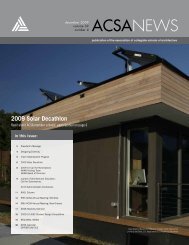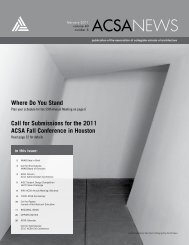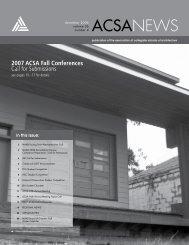digital aptitudes - Association of Collegiate Schools of Architecture
digital aptitudes - Association of Collegiate Schools of Architecture
digital aptitudes - Association of Collegiate Schools of Architecture
Create successful ePaper yourself
Turn your PDF publications into a flip-book with our unique Google optimized e-Paper software.
SATURDAY, MARCH 3, 2012 - 12:30PM - 2:00PM<br />
Design Continued<br />
Ornate Screens<br />
Daniel Baerlecken, Georgia Institute <strong>of</strong> Technology<br />
The project “Ornate Screens” investigates ornamentation <strong>of</strong> 3-dimensional<br />
surfaces through <strong>digital</strong> tools, which allow the re-introduction<br />
<strong>of</strong> variation. Ornament has been abolished by the avant-garde in the<br />
first half <strong>of</strong> the twentieth century and ornamentation has been replaced<br />
by material aesthetic. With this project we will argue that ornament<br />
is not a parergon, an unnecessary accessory, but that the parergon,<br />
the ornament, actually becomes the ergon, the main element.<br />
In that sense ornament becomes performative in two ways. Firstly,<br />
ornament performs in a perceptual way. With Ernst Gombrich we argue<br />
that aesthetic enjoyment is guided by the “sense <strong>of</strong> order” “as an<br />
active agent reaching out toward the environment, not blindly and at<br />
random”, but structured. Ornamentation allows “Einfuehlung” - empathy,<br />
the identification with an object.<br />
Secondly, we argue that ornament can perform on the level <strong>of</strong> the<br />
ergon as structural system.<br />
The project has two design foci: the first focus is the design <strong>of</strong> a series<br />
<strong>of</strong> lights, which are fabricated through STL and SLS technologies. The<br />
objects are brought to life primarily as single objects without joints or<br />
seams as ‘additive fabrication’. By that, the objects can be produced<br />
directly from <strong>digital</strong> information as unique pieces. Each light can be<br />
different from the other, but still belong to the same family. Changing<br />
variables in the original script allows creating a different light, which<br />
still can feed back to a greater family. Mass production is replaced<br />
with mass customization. One can create unique objects by manipulating<br />
the parameters.<br />
The second project is an installation, a CNC fabricated wood construction<br />
that demonstrates how a pattern based geometry can be<br />
optimized structurally through a set <strong>of</strong> iterations. The tessellationbased<br />
project is adapted in order to achieve a maximum <strong>of</strong> structural<br />
strength. The structural calculation model contains not only geometry<br />
but also loads resulting from various sources.<br />
The design <strong>of</strong> a series <strong>of</strong> lights demonstrates the potential <strong>of</strong> CAAD<br />
and CAAM tools for a design object and shows how these tools allow<br />
us to re-think the relationship <strong>of</strong> author and user: Through parametric<br />
tools each user can design its own light within certain constrains. The<br />
second project shows how parametric tools can be used to optimize<br />
geometry to achieve a structural performance.<br />
Ornament can be re-introduced as ergon that allows strengthening<br />
empathy between subject and object and that allows solving problems<br />
<strong>of</strong> performance. Ornament becomes necessary again.<br />
the NEXT curtain<br />
Virginia San Fratello, San Jose State University<br />
The inherent nature <strong>of</strong> 3D printing opens new possibilities for shaping<br />
materials and it’s my belief that this process will reshape the way we<br />
design and fabricate architectural and interior building components.<br />
Digital materiality, a term coined by Italian and Swiss architects Fabio<br />
Gramazio and Matthias Kohler, describes materiality increasingly enriched<br />
with <strong>digital</strong> characteristics where data, material, programming<br />
and construction are interwoven (Gramazio and Kohler, 2008). The<br />
designs for these two curtains were created as an exploration into the<br />
rapid manufacture <strong>of</strong> interior building components that are not only<br />
made through the process <strong>of</strong> 3D printing, but are all also responsive<br />
to the environment.<br />
Unique, one <strong>of</strong> a kind building components, generated quickly and<br />
economically, from advanced 3 dimensional modeling s<strong>of</strong>tware were<br />
explored. These 3D printed curtains were studied in conjunction with<br />
solar conditions throughout the day and year and <strong>of</strong>fer an alternative<br />
to traditional curtains and blinds, one that is responsive to weather, to<br />
views and to interior programming.<br />
Exploration #1: The WAVE curtain is a passive solar curtain that is<br />
designed to admit the low winter sun into the building interior and restrict<br />
the direct, intense summer sun in order to help keep the interior<br />
cool. The curtain does this through the use <strong>of</strong> cylindrical tubes that<br />
vary in width and depth along the length <strong>of</strong> the window. Because the<br />
cylindrical tubes are hollow one always has access to exterior views<br />
-even when the sun is being blocked - unlike a typical shade or curtain.<br />
The curtain is 3D printed <strong>of</strong> white poly lactic acid from renewable<br />
resources such as corn starch.<br />
Exploration #2: The HEX curtain is designed to open and close automatically<br />
in response to natural day lighting conditions. Each row <strong>of</strong><br />
the HEX curtain is composed <strong>of</strong> hexagonal shaped apertures that are<br />
covered by 2 operable shields. The 2 shields have the ability to pivot<br />
open and closed. The shields are hinged at the bottom and threaded<br />
at the top. The top thread connects each shield to the one next to<br />
it. At the end <strong>of</strong> each row a rotary motor pulls the thread and slowly<br />
opens or closes the shields in tandem. The rotary motor is driven by<br />
an arduino microcontroller connected to a solar sensor so on a sunny<br />
summer day the shields remain closed and on a sunny winter day the<br />
shields are automatically opened to allow sun to enter the interior and<br />
warm the space.<br />
The HEX curtain is constructed <strong>of</strong> laser sintered nylon and is 3D printed<br />
in 27” x 22” panels.<br />
The Next Generative Infrastructure for Detroit<br />
Constance Bodurow, Lawrence Technological University<br />
Detroit has a wealth <strong>of</strong> empty space, though little intelligence or understanding<br />
<strong>of</strong> it. There is a global, morbid fascination with Detroit’s<br />
emptiness. The media and design disciplines have mythologized it<br />
in imagery and obsessively mapped and quantified it (the reported<br />
yet disputed 40,000 parcels). Vacancy perpetuates entrenched<br />
social, economic and environmental disparities and inequities, but,<br />
in the midst <strong>of</strong> formal ‘right sizing’ and informal urban agricultural<br />
initiatives, a constructive civic dialogue about the role <strong>of</strong> vacancy in<br />
the future <strong>of</strong> the city has yet to begin.<br />
Our transdisciplinary design research lab wishes to prompt the dialogue.<br />
We believe that a new urban geography and ecosystem are<br />
required to balance the benefits and impacts <strong>of</strong> both shrinking and<br />
rapid urbanization and leverage the assets and complex combinations<br />
<strong>of</strong> forces <strong>of</strong> the city-scape. We look at vacancy as a new infrastructure<br />
for the city. We see vacancy, as it manifests: in land,<br />
buildings and infrastructure, as generative. Vacancy provides an<br />
armature for collective dialogue, design intervention and policy. We<br />
recommend a variety <strong>of</strong> productive, temporal uses for vacancy, to<br />
generate the next urban form <strong>of</strong> the city. In the same manner that<br />
the grid and infrastructure become a generator <strong>of</strong> urban form and<br />
use (Smithsons, Varnelis, Belanger, et al), vacancy can guide future<br />
urban form in Detroit.<br />
Digital Apptitutes + Other Openings - Boston, MA - 43








